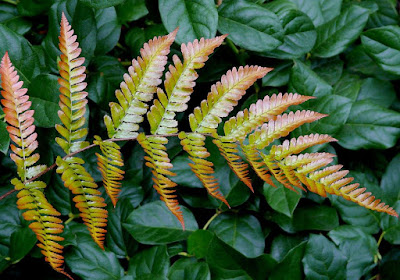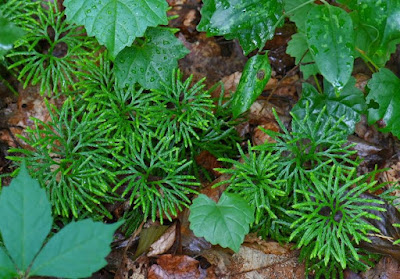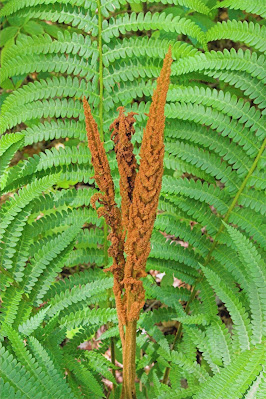Leader for
today's Ramble: Linda Chafin
Author of
today’s report: Linda Chafin
Fungus and insect identifications: Don Hunter
Link to Don's Facebook page for this Ramble. All the photos that appear in this report, unless otherwise credited, were taken by Don Hunter.
Today's emphasis: Ferns in the Lower Shade Garden and Dunson Native Flora Garden
21 Ramblers today
Show-and-Tell:
Both Gary and Michael brought in a frond from the same fern species – Kunth's Maiden Fern – for identification. This is a widely planted ornamental species as well as a common fern of moist, limestone-based lowlands in the Coastal Plain.
Halley brought in a single flower from her Eastern False-aloe plant. Don has been posting a series of photos of the developing flowers on an Eastern False-aloe he found at one of his Ga Power ROW meadows. Eastern False-aloe is the only agave native to Georgia.
Announcements: Sandy recommended “The Genius of Birds” by Jennifer Ackerman, and Linda seconds it. As this review puts it, “This book is a delight… There is another world of intelligence out there, and this is a great introduction to it.”
 |
| Some early arriving ramblers were greeted by a Carolina Anole on the split rail fence. |
Who would be a turtle who could help it?
A barely mobile hard roll, a four-oared helmet,
she can ill afford the chances she must take
in rowing toward the grasses that she eats.
Her track is graceless, like dragging
a packing case places, and almost any slope
defeats her modest hopes. Even being practical,
she's often stuck up to the axle on her way
to something edible. With everything optimal,
she skirts the ditch which would convert
her shell into a serving dish. She lives
below luck-level, never imagining some lottery
will change her load of pottery to wings.
Her only levity is patience,
the sport of truly chastened things.
Today's Route: We left the Children’s Garden arbor and wound our way through the Shade Garden and the Dunson Native Flora Garden, before heading back up to the Children’s Garden.
As we were examining the show-and-tell fern specimens, Dave asked a question that is key to understanding what ferns are all about: What is the difference between a fern spore and a seed?
Spores are single-celled reproductive structures produced by meiosis, a type of cell division that reduces the number of chromosomes in the cell’s nucleus by half. Thus, the spore cell has only half the number of chromosomes in its nucleus that its parent has (haploid or 1n). In contrast, seeds are made up of many, many cells – each with a full complement of chromosomes (diploid or 2n), half from one parent, half from the other. Ferns spores are produced inside tiny structures called sporangia that are grouped together into numerous “sori” (singular: sorus). Sori are most often found on the lower surface of fern leaflets, though occasionally occur elsewhere on the plant (more later).
 |
| Spore-bearing sori on the lower surface of a Kunth's Maiden Fern leaf |
Once an egg and sperm unite, a diploid zygote with the full complement of chromosomes begins to develop into the leafy, green plant we know as a fern. Botanists call this showy, leafy stage of the plant’s life a “sporophyte” because it is the spore-producing part of the fern’s life cycle–which brings the cycle back to where we started. This two-phase cycle of reproduction – partly haploid, partly diploid – is called “alternation of generations,” and is found in all the so-called “primitive plants,” the ones that have been around hundreds of million years, long before the seed- and flower- producing plants, and even before dinosaurs. So, reproduction by alternation of generations may seem inefficient and contingent in the extreme, but it has worked for these plants a very long time. It’s true that there are more than ten times as many seed-producing plants than ferns, but there is more than one way to measure success and persistence is a good one.
Fern Leaf Terminology:
As most people know, fern leaves are often called fronds. Less well known is the term for a fern leaflet: a pinna (plural, pinnae). Mariana Island Maiden Fern fronds are divided into many widely spaced pinnae which are, in turn, divided into subleaflets called pinnules. It is the repeated division of the fern frond that people mean when they describe a plant as looking “ferny.”
 |
| The invasive Mariana Island Maiden Fern has widely spaced pinnae that are subdived into pinnules. |
Mariana Island Maiden Fern is a native of the Asian and African tropics. Its invasiveness was on display here in the Shade Garden where it has spread well beyond its original planting by a far-reaching network of rhizomes and also by spores. It has also become established in the forests surrounding the Garden. Once confined to limestone habitats in Florida, this exotic has spread throughout the lower south into many kinds of moist, shady habitats. It should be eradicated wherever found.
Native Ferns of Upland Habitats:
Southern Shield Fern (or Kunth’s Maiden Fern) is planted widely throughout the shadier parts of the Bot Garden. It is native to limestone-based habitats in the Coastal Plain but is widely available in the nursery trade and is planted in gardens throughout the southeast. The upper leaf surface is usually softly and finely hairy and has many tiny stalked glands. The leaf stalks are pale yellowish-tan ad have brown scales near the base.
 |
| Kunth's Maiden Fern |
 | |
|
Southern Lady Fern is found in moist forests throughout the southeast. Lower elevation plants have reddish stalks; mountain plants (above 3,500 feet or so) have green stalks. Both have been planted in the Dunson Garden. This species is distinguished by the shape of its pinnae – they are about the same width for most of their length then abruptly taper to a point, a shape known to botanists as “acuminate.” With a hand lens, you can see that its spores are produced in tiny, crescent-shaped sori on the undersides of the leaflets.
 |
| Southern Lady Fern with its sharply tapered pinnae. |
 |
| Tiny crescent-shaped sori on the
underside of Southern Lady Fern pinnae Photo by Muriel Bendel, https://commons.wikimedia.org/wiki/File:Athyrium_filix-femina_Sori_Tannwald1.jpg |
 |
| Christmas Fern grows in nearly
every county in Georgia, in a wide range of habitats from dry upland woods to streamside bottomlands. |
 |
| Christmas Fern has evergreen fronds bearing many stocking-shaped pinnae |
 |
| Christmas Fern sori are produced on specialized pinnae at the tips of the fronds |
 |
| Broad Beech Fern is distinguished by the lowest pinnae, which angle away from the rest of the frond. This peculiar trait has earned it a Rambler-bestowed nickname, foxhead fern. |
 |
| Autumn Fern. Photo by James Gaither https://www.flickr.com/photos/jim-sf/2792457827 |
Wood Ferns are in the genus Dryopteris, which also includes the popular landscaping plant, Autumn Fern (Dryopteris erythrosora), named for the autumnal colors of its pinnae in the spring. This species is increasingly found in wooded areas that border suburban neighborhoods -- it is escaping from gardens and invading native habitats. It has already become a problem in Atlanta’s wooded city parks.
 |
| Running-cedar or Ground-cedar |
Running-cedar or Ground-cedar, a fairly common plant of acidic upland woods, is neither a fern or a cedar, but a clubmoss (though it’s not a moss either), more properly called a “lycophyte” (from the Greek 'lyco' meaning wolf, go figure). Lycophytes are a large group of non-flowering plants traditionally called “fern allies” because, like ferns, they reproduce by spores. Recent genetic studies have shown that they are not closely related to ferns or any other vascular plant, for that matter. These are ancient plants, having formed vast forests during the Devonian period (about 400 million years ago) that now make up coal deposits.
Ferns of Wetland Habitats
 |
| Royal Fern, a species found in shady wetlands, has widely spaced pinnae subdivided into many oblong pinnules. |
pinnae at the tips of the fronds
Cinnamon Fern is a common wetland species that produces spores, not on its normal leaflets, but on a separate leaf that is specialized for spore production. The fertile, spore-bearing leaves are a rusty orange color, hence the common name (fertile fronds were not seen today).
 | |
| Fertile fronds rising from the center of a Cinnamon Fern plant and surrounded by sterile fronds. Photo courtesy of https://pxhere.com/en/photo/1050642 |
Cinnamon Fern fronds are divided into pinnae that are lobed, but not quite completely divided into pinnules -- there is a tiny amount of leaf tissue between the lobes. At the base of each pinna, there is a patch of white or tan hairs.
 |
| Cinnamon Fern's "hairy armpits" distinguish it from similar species. |
 |
| Insect herbivores typically leave ferns alone but the larvae of a sawfly, Hemitaxonus dubitatus, feed upon the leaves of Sensitive Fern. |
 |
| Netted Chain Fern is named for the
chain-like pattern of small veins that line the midvein of every lobe. These are best seen on the lower leaf surface |
It wasn’t “all ferns, all the time” on today’s ramble. Some wonderful early summer sights greeted us in the Shade and Dunson Gardens, including:
 |
| Jellied False Coral Mushroom |
 |
| Shrubby St. John’s Wort |
 |
| Black Cohosh is in full bloom, its flowering spikes lighting up the deep green of the forest. |
 |
| Jackson's Slender Caesar mushrooms also glowed on the forest floor. |
SUMMARY OF OBSERVATIONS:
Mariana Island Lady Fern Macrothelypteris torresiana
Widespread Maiden Fern, Kunth’s Maiden Fern, Southern Shield Fern
Thelypteris kunthii, synonym Christella kunthii
Southern Lady Fern Athyrium asplenoides, synonym Athyrium filix-femina
Shrubby St. John’s Wort Hypericum prolificum
Sycamore Tussock Moth (caterpillar) Halysidota harrisii
Arborvitae Fern (a spikemoss) Selaginella braunii
Black Cohosh Actaea racemosa
Cinnamon Fern Osmundastrum cinnamomeum, synonym Osmunda cinnamomea
Christmas Fern Polystichum acrostichoides
Royal Fern Osmunda regalis
Mayapple Podophyllum peltatum
Ebony Spleenwort Asplenium platyneuron
Sensitive Fern Onoclea sensibilis
Ashe Magnolia Magnolia ashei
New York Fern Thelypteris noveboracensis
Broad Beech Fern Phegopteris hexagonoptera
Goldie’s Wood Fern Dryopteris goldieana
Marginal Wood Fern Dryopteris marginalis
Netted Chain Fern Woodwardia areolata
Jackson’s Slender Caesar mushroom Amanita jacksonii
American Witch Hazel Hamamelis virginiana
Running (Ground) Cedar Diphasiastrum digitatum
Seersucker Sedge Carex plantaginea
Smooth Chanterelle mushrooms Cantharellus lateritius
Jellied False Coral Mushrooms Sebacina schweinitzii
American Lopseed Phryma leptostachya







